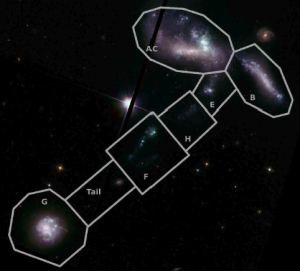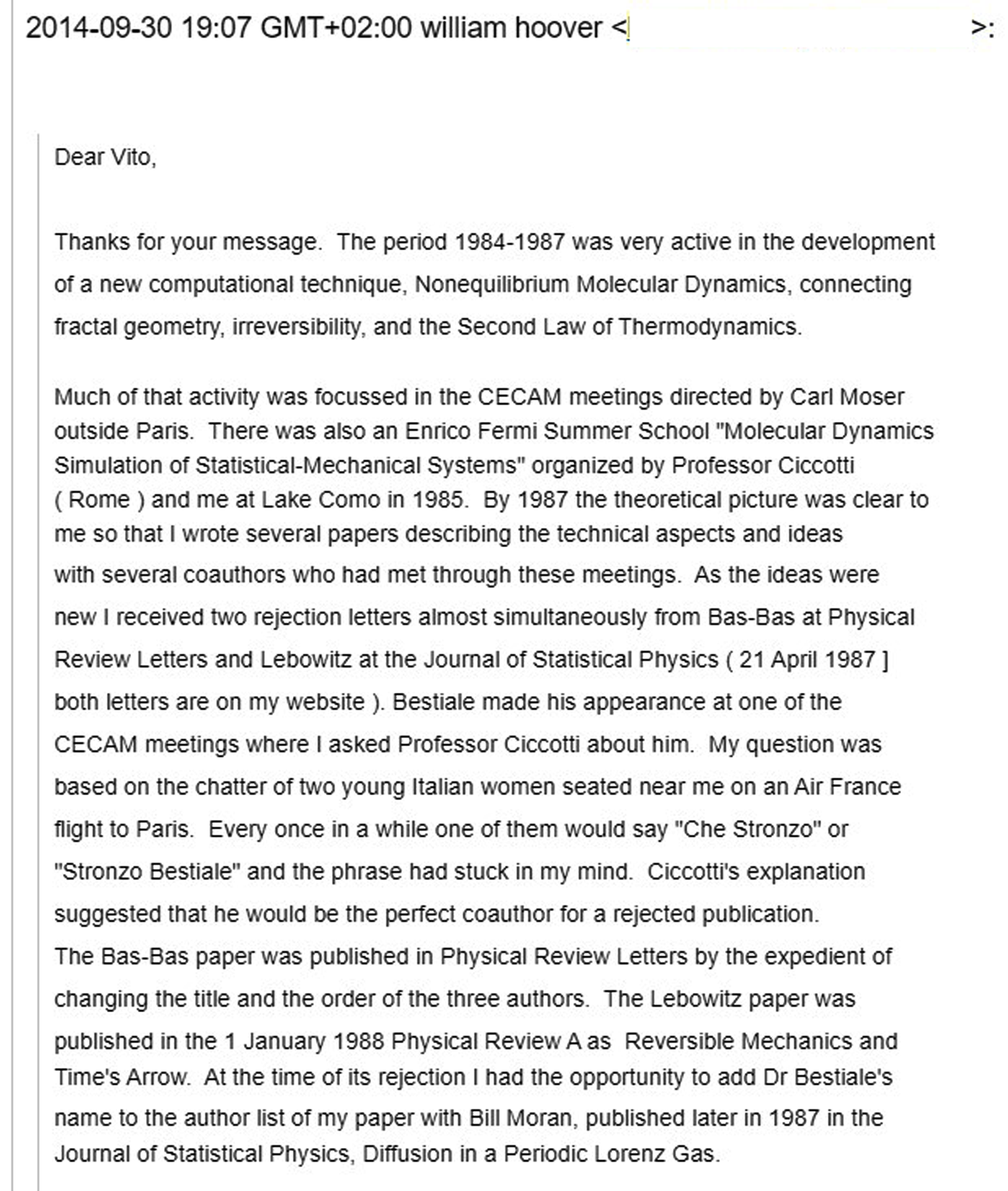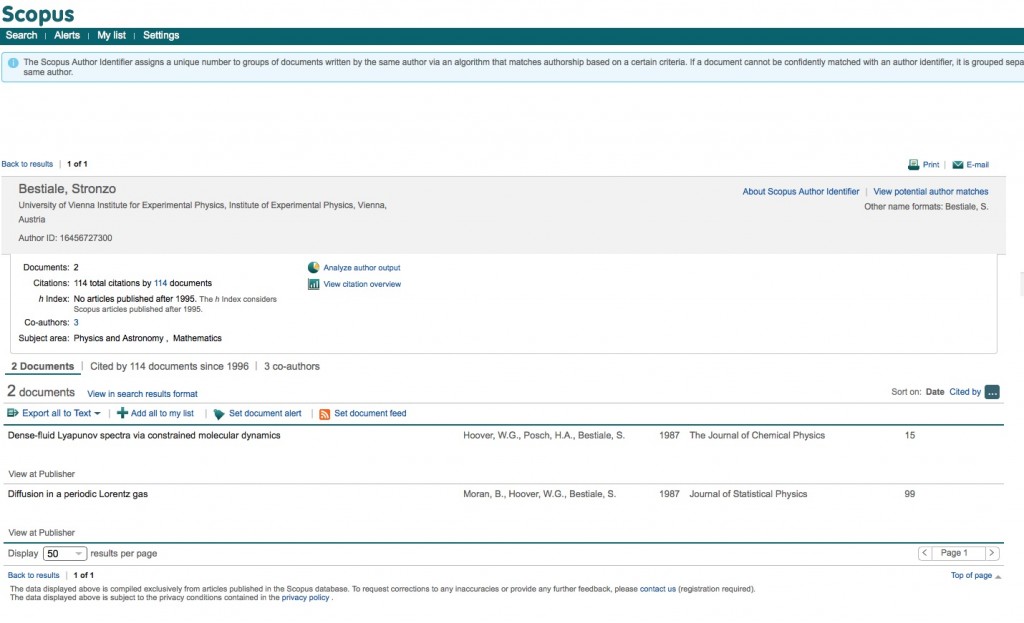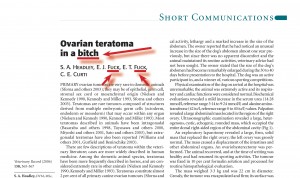 When Luc – a reader of this blog – pointed me a study containing the words “fuck, fuck, bitch”, I thought it was another sensational joke (do you remember the case of Stronzo Bestiale?).
When Luc – a reader of this blog – pointed me a study containing the words “fuck, fuck, bitch”, I thought it was another sensational joke (do you remember the case of Stronzo Bestiale?).Following his cue, with some skepticism I typed those 3 words on PubMed, the most important database on biomedical research worldwide. And I got the first surprise: the research really exists (click to enlarge).
It’s entitled “Ovarian teratoma in a bitch” and is signed by ,,, C. E. Curti. The study was published in 2006 by “Veterinary record“, the Journal of the British veterinarians. In fact, bitch means both “female dog”, as well is a pejorative (a woman who is belligerent, unreasonable, malicious, a control freak, rudely intrusive or aggressive).
Then, the research was about ovarian cancer. But the authors Fuck E. J., and. T. Fuck? I was sure they were invented: the research title was, probably, an irresistible temptation for the true author of the paper.
Maybe there was another scientific joke to report about. So I set out on the trail of the first author, Headley, and it was not easy to find him with just the initials. Finally I found him: he is Selwyn Arlington Headley, an adjunct professor in the Department of Veterinary Preventive Medicine, State University of Londrina in Paranà, Brazil.
 And his response was another surprise: “The research is not a joke, and I am the lead author of it. The two authors surnames, which are not unusual, are really Fuck and Fuck: they are the owners of a veterinary hospital in southern Brazil”. For the record, they’re called Egon José Fuck, and Eliane Miranda Thomaselli Fuck (click to enlarge). So, this time the credibility of science is safe: no one has attempted to mock the scientific controls system. But why not entitle the research “Ovarian Teratoma in a German shepherd”? That research would have had a less embarrassing impact. But maybe it would not have passed into history.
And his response was another surprise: “The research is not a joke, and I am the lead author of it. The two authors surnames, which are not unusual, are really Fuck and Fuck: they are the owners of a veterinary hospital in southern Brazil”. For the record, they’re called Egon José Fuck, and Eliane Miranda Thomaselli Fuck (click to enlarge). So, this time the credibility of science is safe: no one has attempted to mock the scientific controls system. But why not entitle the research “Ovarian Teratoma in a German shepherd”? That research would have had a less embarrassing impact. But maybe it would not have passed into history.
What moral to draw from this story? Vulgar surnames do exist: professor Mark Liberman, linguist at University of Pennsylvania, noted the case of Professor Connard (dickhead), author of thousands of publications (indeed, they exist, because there is more of one). And Corey Bradshaw, Director of the Environment Institute in Adelaide (Australia) in an ironic article posted on his blog has listed dozens of (real) researches signed by: Bastard, Crap, Dick, Junk, Prick … Reality, in few words, exceeds imagination.
Speaking about signatures, after Stronzo Bestiale case there’s another observation to do. My website has been seen by nearly 90 thousand people in few days and the story has gone around the world, inspiring among other things, a fake account on the site weibo.com in China (click to enlarge).
Professor Bestiale has inspired dozens of researchers and science enthusiasts, who reported me the most amazing research.
I remember two that are stuck in my mind:
| the group of galaxies HGC31, in a sensational phallic shape (page 17 of the study here: Canada-Usa, 2006, “The astronomical journal”); | |
| and a molecular reaction that seems to come from the imagination of a porno graffiti artist (the study here: Brazil, 2004, “Inorganic chemistry”). |
I asked myself the reasons of this unexpected success. I think people like these stories because they reveal the human side of science, also made of jokes, taunts, oversights, errors or misunderstandings. Even scientists have emotions, they like to joke and play. Just like everyone of us.
[ Italian version here ]
The post The strange case of doctors Fuck & Fuck first appeared on Parolacce.]]>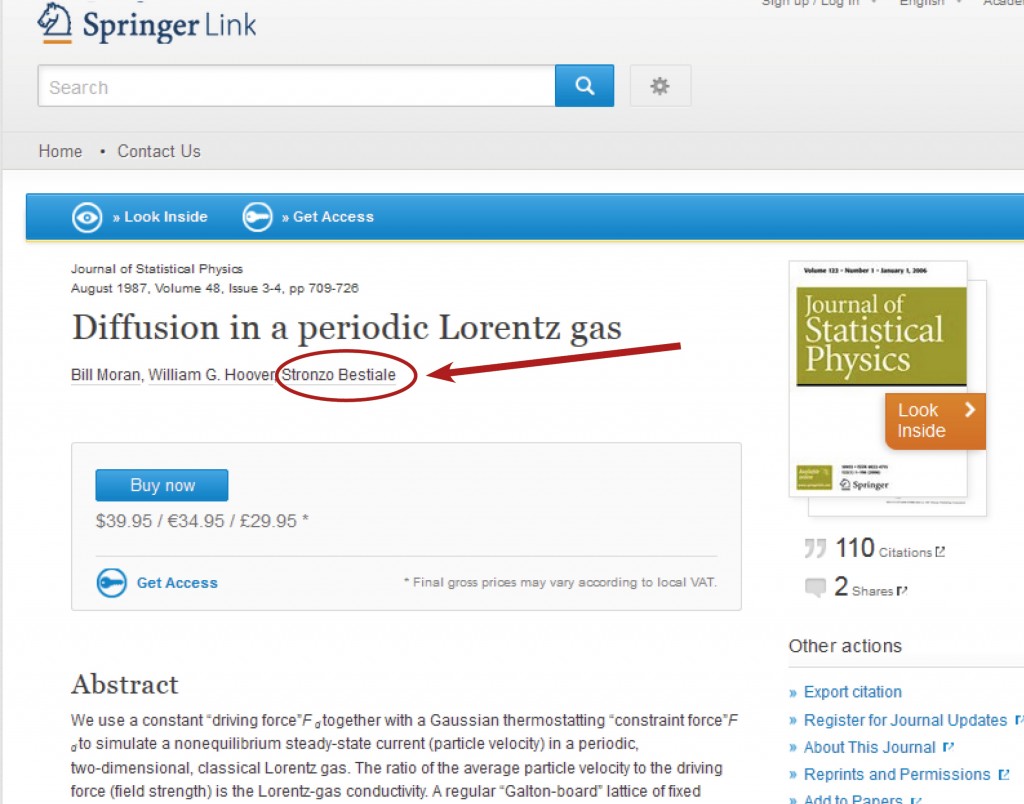 Would you read a paper written by Stronzo Bestiale (Total Asshole)? A dose of mistrust would be justified: the name says it all. Yet, in 1987, professor Bestiale, supposedly a physicist in Palermo, Sicily, authored major papers in prestigious scientific peer reviewed journals such as the Journal of Statistical Physics, the Journal of Chemical Physics and the proceedings of a meeting of American Physical Society in Monterey.
Would you read a paper written by Stronzo Bestiale (Total Asshole)? A dose of mistrust would be justified: the name says it all. Yet, in 1987, professor Bestiale, supposedly a physicist in Palermo, Sicily, authored major papers in prestigious scientific peer reviewed journals such as the Journal of Statistical Physics, the Journal of Chemical Physics and the proceedings of a meeting of American Physical Society in Monterey.Given that surnames always intrigued me (they are the subject of my first book), I tried to find this person in Italian telephone directories. In Italy there are 7 Bestiale, mostly in Piedmont. None of them, however, has the name Stronzo (Turd or a Asshole: who would call their own son that?); between the Veneto and Trentino-Alto Adige there are 4 Stronziero, but this is also a surname.
In fact, Stronzo Bestiale does not exist as confirmed, when those scientific papers were published 27 years ago, by the then Chancellor of the University of Palermo, Ignazio Melisenda Giambertoni (another unusual surname!).
So I decided to investigate more thoroughly. The self-styled Bestiale appears in the papers authored by Bill Moran and William G. Hoover, two influential American scientists from the Lawrence Livermore National Laboratory. In particular, Bestiale appears in various documents authored by Hoover, who also cited him at the end of a very serious physicspaper, saying that “discussions with him were very useful.”
I wrote an email to professor Hoover, now retired, to ask him the true story of Stronzo Bestiale. Here’s what he answered.
«At that time, the period 1984-1987» he says «we were very active in the development of a new computational technique, non-equilibrium molecular dynamics, connecting fractal geometry, irreversibility and the second law of thermodynamics. The idea was born during meetings at CECAM (Centre Européen de Calcul Atomique et Moléculaire) in Lausanne, Switzerland, and the Enrico Fermi summer school organized at Lake Como with Giovanni Ciccotti, professor of condensed matter physics at the University La Sapienza University in Rome. In these meetings, the theoretical picture of this technique was clear to me, so I wrote several papers on the subject along with some colleagues». But the reviewers of Physical Review Letters and the Journal of Statistical Physics refused to publish his texts: they contained too innovative ideas.
This is nothing new: new discoveries in science are hard to publish because scientists are rather conservative, as discussed by the epistemologist Thomas Kuhn. Meanwhile, Hoover continues, «while I was traveling on a flight to Paris, next to me were two Italian women who spoke among themselves, saying continually: “Che stronzo (what an asshole)!”, or “Stronzo bestiale (total asshole)”. Those phrases had stuck in my mind. So, during a CECAM meeting, I asked Ciccotti what they meant. When he explained it to me, I thought that Stronzo Bestiale would have been the perfect co-author for a rejected publication». So he decided to submit his papers again, simply by changing the title and adding the name of that author. And the researches were published.
In short, a pointed joke. Not everyone took it well, at the time: the President of the Italian Physical Society, Professor Renato Angelo Ricci said, «This joke is an offense to the entire Italian scientific community». After receiving several calls in the editorial office from Italian readers asking for explanations about that vulgar author, the editor of the “Journal of statistical physics”, Joel Lebowitz, published a letter of apology in the March 1988 issue: “It has come to my attention that the name given as the third author in the above paper is in fact a rather obscene expression in Italian. I apologize to the readers for not catching this stupidity of the other two authors. ”. The rectification, as often happens, went unnoticed.
In reality, though, this joke laid bare how vulnerable control systems in the review of scientific research were (and still are!) . If you are able to insert in a publication the name of a nonexistent author in a publication, who will guarantee that even the scientific contents have been examined with care? Incredibly, even today, 27 years later, Stronzo Bestiale continues to be present as the author of publications in scientific databases: is it not extraordinary?
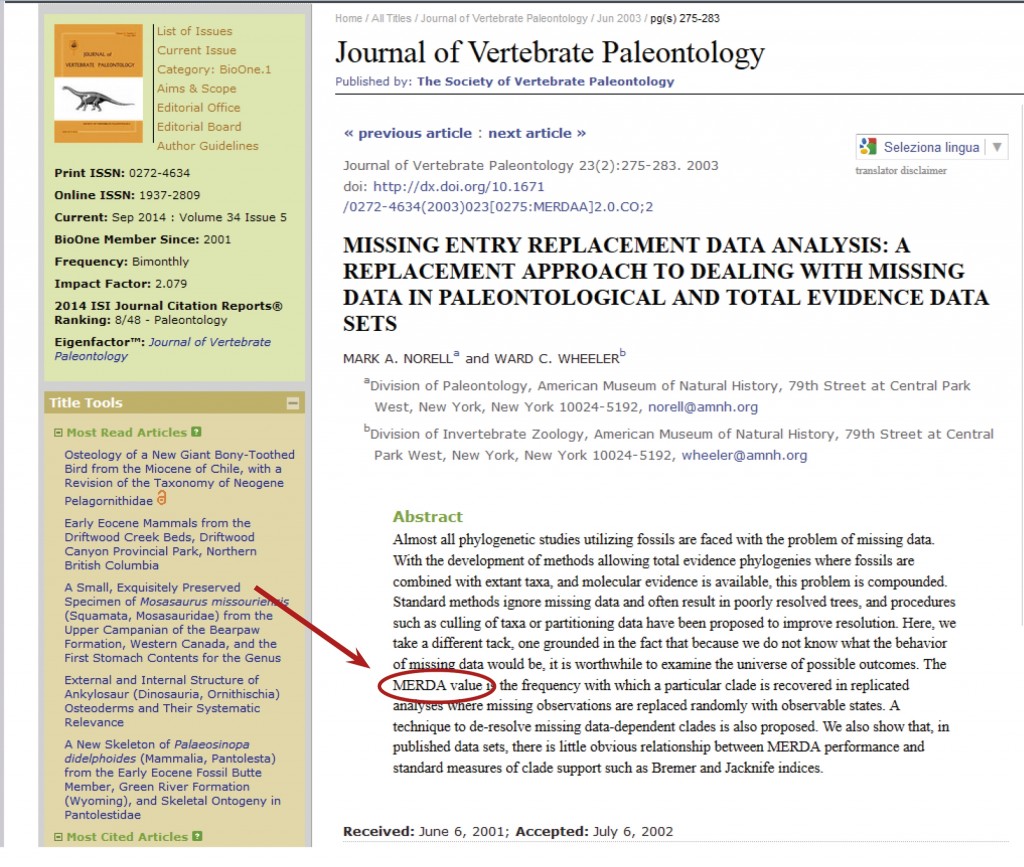 But Stronzo Bestiale is not the only dirty word published in international scientific journals. More recently, in 2003, the Journal of Vertebrate Paleontology published a study on the “MERDA (shit) value”, which stands for Missing Entry Replacement Data Analysis, a technique for phylogenetic reconstruction in paleontology.
But Stronzo Bestiale is not the only dirty word published in international scientific journals. More recently, in 2003, the Journal of Vertebrate Paleontology published a study on the “MERDA (shit) value”, which stands for Missing Entry Replacement Data Analysis, a technique for phylogenetic reconstruction in paleontology.Was this an embarrassing coincidence that the authors realized only after the fact? Far from it!
I asked one of the authors, Ward C. Wheeler, of the division of invertebrate zoology at the American Museum of Natural History for clarification. And he revealed that they knew very well the meaning of “merda” from Catalan: not Italian, but it makes no difference … «We chose that acronym on purpose, to highlight the poor quality of incomplete groups of data. It was a amusing acronym. The procedure, which in the meantime has been further developed, it is still used for the analysis of incomplete fossils samples».
So, scientists do have sense of humor. Fortunately. As for people with vulgar surnames … they do exist. In Italy there are thousands. I will tell their stories in the next post. [click here for italian version ]
UPDATE #1: my collegue Fabio Turone, president of SWIM (Science Writers in Italy, an association of science journalists) sent me the profile of Stronzo Bestiale from Scopus, an international bibliographic and bibliometric database (see screenshot below). In Scopus, professor Stronzo Bestiale appears to be working at the Institute of Experimental Physics, at the University of Vienna, the institutional affiliation attributed to him in the paper published by the Journal of chemical physics. One more point on his résumé!
UPDATE #2: italian research also has had a funny episode with dirty words. Some readers of this blog report a Prin (Research project of relevant national interest), presented in 2011 by researchers from INFN and University of Torino. It was a virtual analysis system for the LHC particle accelerator at CERN in Geneva. The acronym of the system was Vaffa (an abbreviation of vaffanculo, fuck off): Virtual Analysis Facility For the Alice experiment. The project, which you can read about here, was not approved.
 UPDATE #3: a reader of this blog, Ugo Finardi, points out antenna FICA (acronym of Folded Inverted Conformal Antenna): in italian, FICA means cunt. It’s not a coincidence, because this antenna was invented by an Italian couple of engineers who, at the time, worked in the research laboratories of Motorola in the United States, Carlo Di Nallo and Antonio Faraone. The invention has been presented in 2005 at the international symposium of the IEEE (Institute of Electrical and Electronic Engineers).
UPDATE #3: a reader of this blog, Ugo Finardi, points out antenna FICA (acronym of Folded Inverted Conformal Antenna): in italian, FICA means cunt. It’s not a coincidence, because this antenna was invented by an Italian couple of engineers who, at the time, worked in the research laboratories of Motorola in the United States, Carlo Di Nallo and Antonio Faraone. The invention has been presented in 2005 at the international symposium of the IEEE (Institute of Electrical and Electronic Engineers).
UPDATE #4: the funny story of Stronzo Bestiale had an international resonance. It’s cited by american blog RetractionWatch, an observatory of retractions and corrections in scientific papers, edited by Ivan Oransky, professor of medicine at New York University School of Medicine and editorial director of MedPage Today. Oransky recalls a similar case: the immunologist Polly Matzinger, who in 1978 published a study co-authored by entering Galadriel Mirkwood: the name of her afghan hound. It was a way to protest against the use of passive voice in scientific papers (“it was discovered that …”).
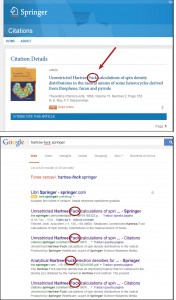 UPDATE #5: the Hartree-Fock method is a procedure in computational physics, which is used to simulate quantum systems. It is named by its discoverers Douglas Hartree and Vladimir Fock. The latter is a Russian physicist with a surname that, in English, is likely to be crippled so vulgar (fuck). And in fact, their method – at a distance of 46 years after the paper that this discovery – has become Hartree-Fuck in Springer publisher’s website (click image to enlarge). And if you type in Google “Hartree-Fuck Springer”, you will get different results mentioning Fuck in the title. Difficult to determine whether it was a mistake or a joke. Or a way to get more clicks on the Web (even by those who make mistakes typing the name)?
UPDATE #5: the Hartree-Fock method is a procedure in computational physics, which is used to simulate quantum systems. It is named by its discoverers Douglas Hartree and Vladimir Fock. The latter is a Russian physicist with a surname that, in English, is likely to be crippled so vulgar (fuck). And in fact, their method – at a distance of 46 years after the paper that this discovery – has become Hartree-Fuck in Springer publisher’s website (click image to enlarge). And if you type in Google “Hartree-Fuck Springer”, you will get different results mentioning Fuck in the title. Difficult to determine whether it was a mistake or a joke. Or a way to get more clicks on the Web (even by those who make mistakes typing the name)?
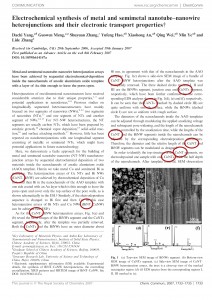 UPDATE #6: a reader of this blog, Andrew White, points out two other vulgar acronyms, contained in a 2007 survey on the electrochemical synthesis of nanotubes: BINT (Bismuth nanotubes, nanorods of bismuth) and CUNT (Cu stands for copper: click image to enlarge). Since this is a research written by Chinese authors, it was almost certainly an accident. But it seems that among chemists had a considerable popularity.
UPDATE #6: a reader of this blog, Andrew White, points out two other vulgar acronyms, contained in a 2007 survey on the electrochemical synthesis of nanotubes: BINT (Bismuth nanotubes, nanorods of bismuth) and CUNT (Cu stands for copper: click image to enlarge). Since this is a research written by Chinese authors, it was almost certainly an accident. But it seems that among chemists had a considerable popularity.
UPDATE #7: professor Mark Liberman, linguist at Pennsylvania University, points out many papers signed Connard (in French, connard means shithead). I checked if one of the most prolific authors, a geologist from Oregon, Gerald G. Connard, really exists: in telephone directories he is present, and probably others. Moreover, people with a vulgar surname are many: among them there must be some scientist!
 UPDATE #8: this morning I discovered that a Us company, Albany Retro Snarky T-Shirts, created a T-shirt about this story, with the inscription “I’m friends with Stronzo Bestiale“. The catch-phrase: “The super funny T-shirt for any scientist!”. Perhaps professor Hoover and me should ask the royalties on this business…
UPDATE #8: this morning I discovered that a Us company, Albany Retro Snarky T-Shirts, created a T-shirt about this story, with the inscription “I’m friends with Stronzo Bestiale“. The catch-phrase: “The super funny T-shirt for any scientist!”. Perhaps professor Hoover and me should ask the royalties on this business… 
UPDATE #9: the Improbable Research organization has re-launched on its website the Stronzo Bestiale story (under “improbable investigators”). Maybe one day prof. Bestiale could win an IgNobel: after a so long carrer, he’d deserve it! Do we candidate him?
 UPDATE #9: Stronzo Bestiale’s story has been reported on Science website.
UPDATE #9: Stronzo Bestiale’s story has been reported on Science website.
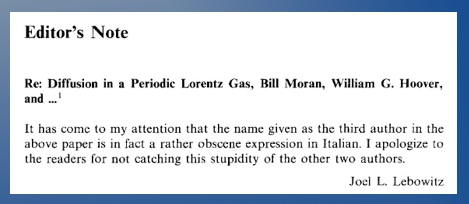 UPDATE #10: also “Scientific american” website tells the Stronzo Bestiale story for the april fool day. The author, Philip Yam, also found a backstory: after the article by Hoover was published, the production editor of the Journal of Statistical Physics, Jim Langlois, received a call from an italian journalist, who asked explanations for this unusual author. And he also explained the meaning of “stronzo bestiale” in Italian. So the joke came to light: in the next issue, the editor Joel Lebowitz wrote an article of apology: “It has come to my attention that the name given as the third author in the paper is a rather obscene expression in Italian. I apologize to the readers for not catching this stupidiy of the other two authors. “
UPDATE #10: also “Scientific american” website tells the Stronzo Bestiale story for the april fool day. The author, Philip Yam, also found a backstory: after the article by Hoover was published, the production editor of the Journal of Statistical Physics, Jim Langlois, received a call from an italian journalist, who asked explanations for this unusual author. And he also explained the meaning of “stronzo bestiale” in Italian. So the joke came to light: in the next issue, the editor Joel Lebowitz wrote an article of apology: “It has come to my attention that the name given as the third author in the paper is a rather obscene expression in Italian. I apologize to the readers for not catching this stupidiy of the other two authors. “
 UPDATE #11: two false profiles of Stronzo Bestiale have been published on Linkedin: one is the “head of quantitative analysis” at a London betting syndicate, the other is a self-styled student from Romagna (Italy) at the University of Leiden. Both have no follower: but their existence testifies that the myth of prof. Bestiale remains alive … even in the professional field!
UPDATE #11: two false profiles of Stronzo Bestiale have been published on Linkedin: one is the “head of quantitative analysis” at a London betting syndicate, the other is a self-styled student from Romagna (Italy) at the University of Leiden. Both have no follower: but their existence testifies that the myth of prof. Bestiale remains alive … even in the professional field!
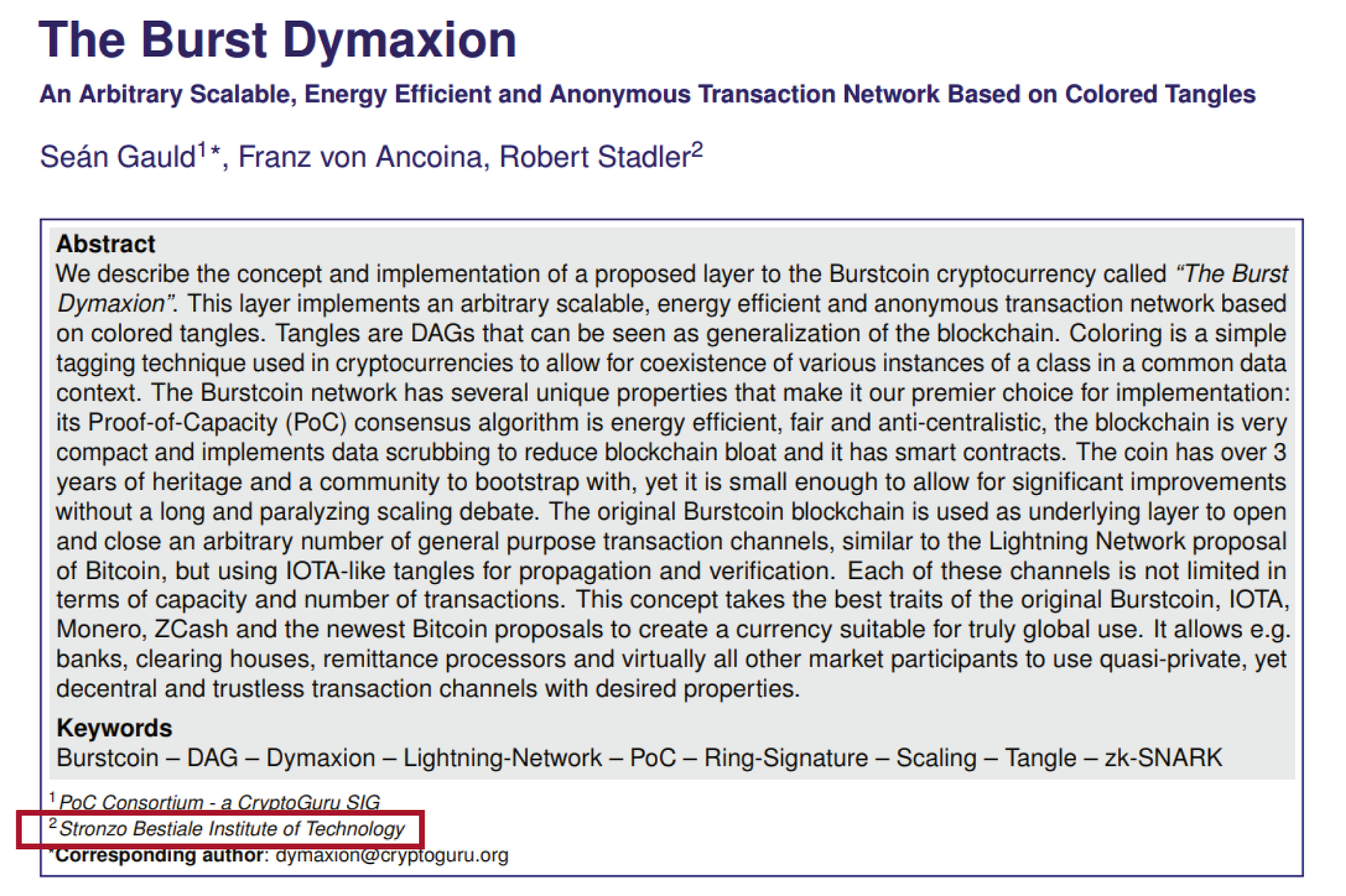 UPDATE #12: Stronzo Bestiale reappeared in a new research published in 2017 on the burst-coin.org website. It’s called “The burst Dymaxion” and talks about cryptocurrencies. Among the authors there is a certain Robert Stadler, who qualifies as a member of the Stronzo Bestiale Institute of Technology, obviously non-existent. And Stadler is also likely to be a pseudonym, given that on the Web the only Stadler that is mentioned is an Austrian designer who has nothing to do with cryptocurrencies. In short, a fake name of a very false institution: among researchers dealing with digital currencies, anonymity is quite common. And in this case there is a note of mocking. [thanks to the biologist Claudio Tiecher who reported it].
UPDATE #12: Stronzo Bestiale reappeared in a new research published in 2017 on the burst-coin.org website. It’s called “The burst Dymaxion” and talks about cryptocurrencies. Among the authors there is a certain Robert Stadler, who qualifies as a member of the Stronzo Bestiale Institute of Technology, obviously non-existent. And Stadler is also likely to be a pseudonym, given that on the Web the only Stadler that is mentioned is an Austrian designer who has nothing to do with cryptocurrencies. In short, a fake name of a very false institution: among researchers dealing with digital currencies, anonymity is quite common. And in this case there is a note of mocking. [thanks to the biologist Claudio Tiecher who reported it].
UPDATE #13: the story of Stronzo Bestiale has been cited on 3 papers dedicated to the “dark side” of science, or to errors or frauds (or jokes, as in this case) that can be conveyed through scientific papers, despite the referee checks. The first study is by Ernesto Carafoli, of the Institute of Molecular Medicine of Padua, and it is intitled “Scientific misconduct: the dark side of science” (2015). The second is by Marta Brunelli, from the Department of Educational Sciences at the University of Macerata, and it is intitled “To peer review or not to peer review? Ovvero: come sopravvivere alle procedure di referaggio” (2015). The third is a study by Samuel Moore et al. (Kings College, London) entitled: “Excellence R Us: university research and the fetishisation of excellence” (2017).
UPDATE #14: a Spanish band, Sin Arreglo, has launched a crowdfunding to finance the recording of a record entitled “Stronzo bestiale”. An explicit tribute to the story told by this blog. The record was published in 2020: “Stronzo bestiale” is also a song (an instrumental one). You can hear it on YouTube.
UPDATE #15: a researcher from CERN in Geneva, Andrea Giammanco, wrote a novel, “Stable charged and massive particles“, which has as its protagonist professor Bestiale (but his name is Sergio). He is the team leader of the tiny group of the Palermo Institute for Advanced Studies. An obvious homage inspired by the story.
Did you like Stronzo Bestiale story? Here you can read a new, true one: dr. Fuck & Fuck, and their patient (a bitch, obvious).
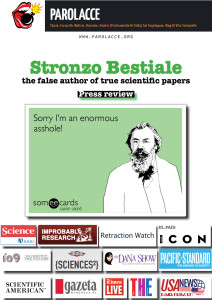 The international Press Review on this story (articles in English, French, Spanish, Portuguese, Greek, Polish, Russian, Chinese, Creole, Italian): → RassegnaStampaStronzoBestiale
The international Press Review on this story (articles in English, French, Spanish, Portuguese, Greek, Polish, Russian, Chinese, Creole, Italian): → RassegnaStampaStronzoBestiale
[ audio ] CHILE, radio Cooperativa (14/10/2014):
Todo es Cierto: Los artículos científicos de Stronzo Bestiale
En Lo que Queda del Día de Cooperativa Paula Molina conversó con el dramaturgo Andrés Kalawski, quien habló sobre los documentos científicos de Stronzo Bestiale y sus coautores.
 [ audio ] BBC radio 4, Inside Science (6/11/2014): from minute 21
[ audio ] BBC radio 4, Inside Science (6/11/2014): from minute 21
Thanks to Sara Scharf for the precious help in reviewing my translation.

